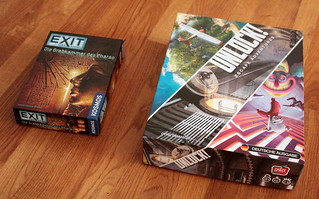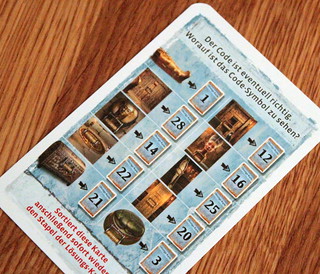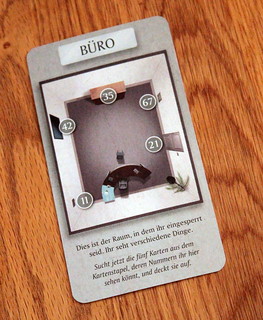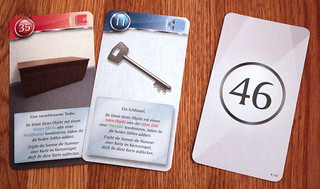I wanted to subtitle this article “Two Escape Rooms enter, one Escape Room leaves” but it sounded too much like nonsense even for me. We probably all know what an Escape Room is by now, but I’ll explain it anyway. Firstly because there might still be someone who doesn’t know. Secondly because I like talking.
An Escape Room is a fun way to spend an evening where you and a couple of friends are locked in a room. Wait, it sounds weird when I say it like that. The point is to escape from that room, usually in an hour or less, by discovering useful items and solving puzzles, both leading to more items and more puzzles, until you finally unlock the Exit and escape. (Unlock the Exit. See what I did there?) Anyway, it’s a great way to spend an evening with friends, and you do it indoors without getting too sweaty.

Doing things indoors and without getting sweaty brings us to the next step in Escape Room evolution: Why would you even leave your living room? You could have a box full of puzzles to solve at home and avoid all that messy outside business. And that’s were Escape Rooms Inna Box come in, a new kind of cooperative game that lets you have the excitement of an Escape Room around your living room table. You could argue if they are boardgames or not, but we’re not going to nitpick that point right now: They’re produced by the same publishers, made by the same designers and enjoyed by many of the same people as more traditional boardgames. People like us, so we’ll review them when we feel like it.
Reviewing Escape Rooms Inna Box is a bit difficult, however. They are pretty light on the rules, so there’s not much to describe without spoiling the experience. “You take cards, you solve the puzzles on them, if you do it right you get more cards. It’s really fun” Doesn’t quite cut it, right? For that reason, and because some of you have been asking which series of ERIBs we recommend, we’ll have a look at the two most popular series currently in the market and then try to answer that question.
EXIT
The series by Inka and Markus Brand is the most well-known series of ERIBs after its first season won the Kennerspiel des Jahres award. We’ll be talking about seasons because both series are getting new games in waves of three, so it seems appropriate. Anyway, EXIT goes for a low tech, low structure approach. Low tech because you don’t need an app, the games only need their deck of cards, their booklet, and their code dial. Low structure because you can almost start playing without reading any rules.

You have a booklet with letters, floor plans, and parts of puzzles too big to put on cards. Everything in the booklet is public information from the start, and you should have a look at everything so you can make the connection with things that come up on the cards.
Solving puzzles from the booklet or from the cards will yield a number that you set on the code dial. The code dial will then tell you which card in the deck to check, and if the code was right that card will give you a new puzzle, or a clue you need to solve one you already have. If the code was wrong the card you find will tell you that you messed up and you have to try again. There is no other penalty for trying wrong codes, it’s bad enough that you wasted your time. You basically keep doing that until you find a card that says YOU WIN!
Also in the cards is a help system in case you get stuck somewhere. For each puzzle there are hint cards you can look at if you can’t figure something out, mostly with vague hints on the first card and full instructions what to do on the last. The number of hints you needed and the time you took to solve the game give you your score.

The games from the first season trap you in an abandoned mountain hut, a Pharaoh’s burial chamber, and a secret laboratory. All three adventures run on the same mechanics, but with their own puzzles. They all share that you might be able to play them without destroying any components, but you’d just be making things hard for yourself. Folding pages in the booklet and cutting up cards is part of the game, so do it. You won’t be able to play the game again anyway because you know the solutions. All you’re losing is the chance to resell a 13 Euro game. That’s a very good price for an hour of fun for six people.
Unlock
With the Kennerspiel award EXIT joins a very exclusive club, but Unlock doesn’t fear that comparison. The As d’Or Jeu de l’Année it won puts it on the same level of international prestige. This series is also notable because publisher Space Cowboys had already shown how going through a deck of cards could become an adventure with T.I.M.E. Stories.

Compared to EXIT, Unlock is high tech, high structure. High tech because downloading the Unlock app to your phone or tablet is mandatory. Here’s where you enter the codes you discover, where you find the help system and where you listen to audio puzzles. No app, no play. High structure because you do need to know a few rules. Not many, but a few, mostly about different kinds of cards.
The cards in Unlock come in different colors. There are item cards in red and blue, and you can try to combine two cards of different colors by adding their numbers, and that may lead you to another card. Simple example, you might have a red lock, a blue key, and combining them gives you a new card of an open cabinet. Combining cards that don’t go together might just give you nothing, or it might lead you to a card with a penalty. Those really hurt, pressing the penalty button in the app takes something like three minutes of the timer.
There are also green cards, what the game calls machines, where you have to solve a puzzle to arrive at a number that you then combine with the number on an object card to get somewhere. And finally, grey cards are everything that doesn’t combine with other things. Letters, maps, random hints, rooms you explore, desk drawers you open, all those might be grey cards.

Besides the puzzles, Unlock captures some of the exploration aspect of an Escape Room. Part of that is playing with items and seeing what can be used together, another part is looking for hidden objects all over the place. Cards showing parts of the scenery often have small numbers hidden somewhere that, when discovered, will give you new objects that you pull out from behind the heating, for instance.
The three episodes of Unlock put you in an abandoned laboratory below the New York subway, in the base of a mad scientist who’s going to blow up the planet and in the archaeological collection of an obsessed billionaire. You personally still won’t explore any of those places more than once, but you don’t destroy any pieces of Unlock, so you can pass it on to your friends when you’re done.
So? Which one is better now???
I’m sorry, you guys. I know I promised the battle of the ERIBs, but I can’t just go and tell you one is better than the other. We had three fun hours with both series, they both deserve the awards they won. But they do have strong and weak points, if you only want to start one series maybe those can help you decide.
Unlock does, in my opinion, a better job at capturing the authentic escape room experience. It’s not all puzzles, figuring out how objects go together and finding hidden objects is part of the fun. The exploration part is more present here, and that’s awesome. But what Unlock gives with the one hand it takes away with the other. You have things to explore, but the punishments for experimenting can be harsh. I have a napkin – do I use it to wipe the grime of another object to see if something is written there or do I slide it under the door to try and catch the key on the other side. I guess I’ll just get a hint what to do with it, because doing it wrong will cost us three minutes. It’s a fictional example, but you see what I mean. Exploration can be punished.

You most likely won’t finish an Unlock game without hints, anyway, because some of the puzzles are not as obvious as they might be. Especially the hidden objects are easy to miss, and not having them may leave you completely stumped on a later puzzle.
In contrast, EXIT is a finely balanced game. It emphasizes the puzzle part of an Escape Room, but on that part it has a great estimate how long players should take. We only needed one hint between the three games, but we didn’t finish any of them in less than 55 minutes. The estimate how long the players should take to solve the puzzles is on point, you’ll be rushed but it’s doable.
The accurate timing is possible because EXIT is pretty conservative with its scenarios, it doesn’t do anything outrageous with the idea of an Escape Room. That’s another point in favor of Unlock, it explores more of its design space. Without fear of spoilers because it happens in the setup of one scenario, Unlock does things like split the group and have people land in different places where they have to get the radio working before they’re even allowed to communicate. That’s the sort of bold idea I miss in EXIT.
Summing it up, what does that mean? The two series have a slightly different focus. The Unlock games are adventure games with some puzzles for variety. Think of point’n’click adventures like Monkey Island or the more recent but equally awesome Thimbleweed Park. Unlock is that as a boardgame for more people. EXIT is a series of somewhat connected puzzles with an adventure story in the background. The narrative is much less strong, but it takes more care to let you have a satisfying victory where you escape in the nick of time and don’t go through all your hints. Depending which aspect is more important to you, pick one or the other. Or still get them all, because these games are an awesome way to kill an evening with friends. Even with those friends who aren’t into more traditional boardgames.











